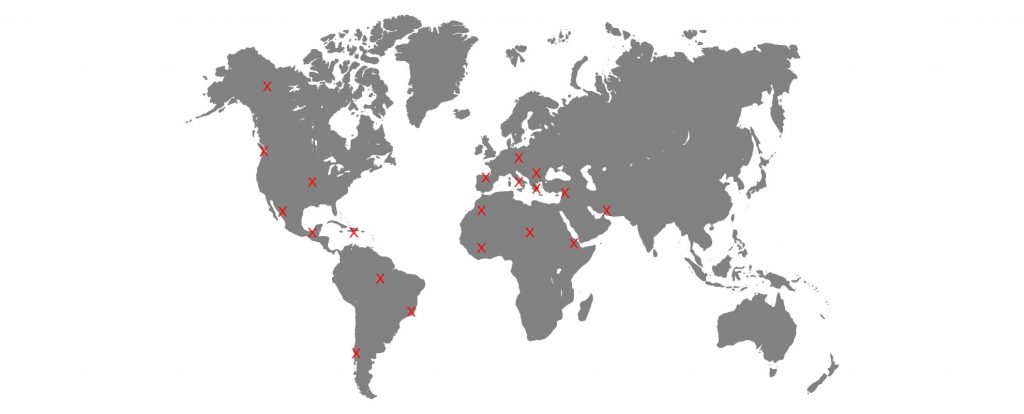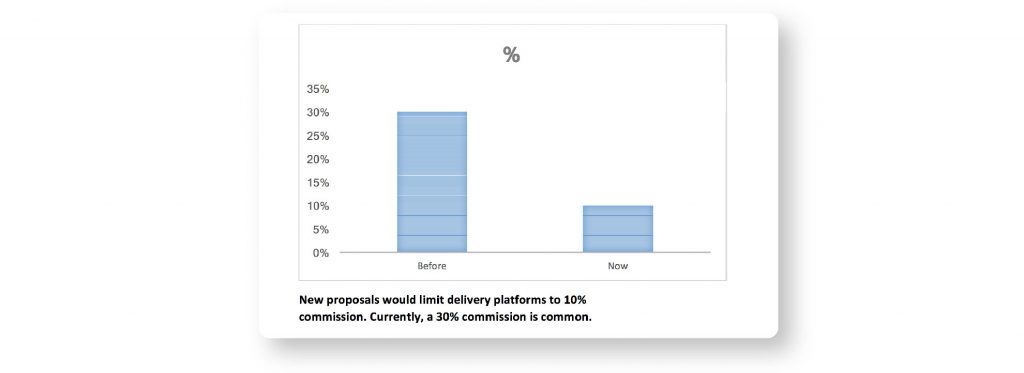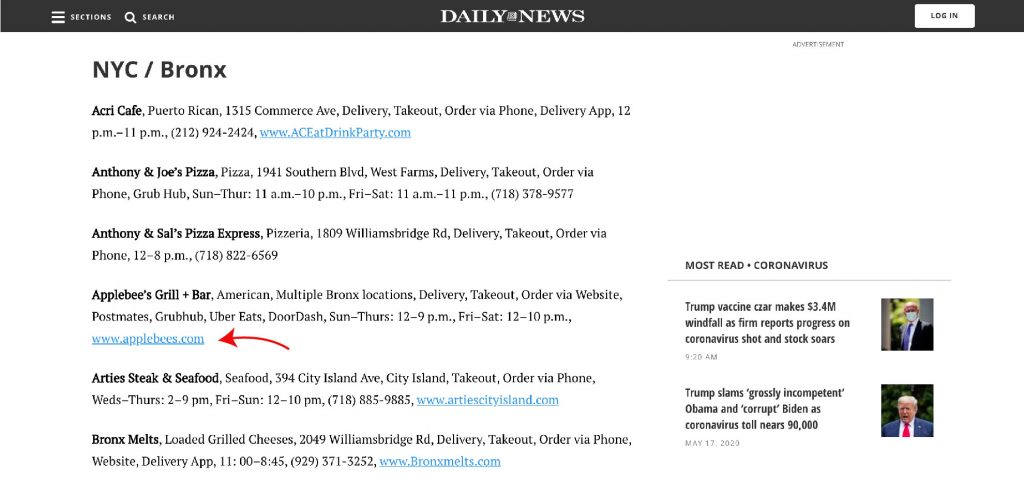
Restaurant Owners & COVID Recovery: Start Fighting Back Now17 min read
By the end of March, 2020, foot traffic in U.S. restaurants had declined 90 percent.
Indeed, COVID-19 brought with it an end to the longest period of U.S. economic expansion on record. From 2009 to 2019, the economy saw gain after gain. It was a glorious 128 month period—until it all came crashing down. In the aftermath, society has come to realize just how vulnerable we still are to disease. There’s little doubt that researchers will find a vaccine for this novel virus. But in the meantime, thousands of restaurant owners wonder whether they’ll survive.
In this post, we’ll explore what you can do to make the most of the downtime you likely find yourself with right now. First, we’ll set the stage by looking at the overall situation. Then we’ll look at a few new ideas that could help the restaurant industry as a whole rebound. Finally, we’ll wrap up with things that you can do, as the restaurant owner, to fight back.
Consumers & Logistics
Of particular concern is the vulnerability of the global supply chain.
With the economy more global than ever before, any attempts to contain COVID-19 will cause disruption. Rapid globalization got under way in earnest in the year 2000, when many industrial choke points were resolved at the same time. But these innovations relied on new technologies. Namely, the Internet, SaaS solutions and smart manufacturing practices. But with the outbreak of COVID-19, quarantines, travel bans and closed ports mean that these high-tech supply chains are vulnerable. They could come crashing down. At the end of the day, we still need people at the helm.\
Meanwhile, foot traffic across the restaurant industry has plummeted since late 2019. As consumers are ordered to stay home, the inventory we do have goes unused. As restaurants close, this inactivity sends a ripple out across other industries, too, such as bulk food production, alcohol production, farming, and shipping.
According to Peter Alexander, of the University of Edinburgh, one reason our economy is so vulnerable is the reliance on just-in-time logistics. This is a production framework that encourages complacency and reliance on shipping. But what happens when shipping is disrupted? Just-in-time logistics is very good at dealing with local disruptions. The overall system simply shifts resources from one place to another. But when the disruption is global, the entire system can collapse. Why? Because just-in-time logistics encourages purchasing parts, ingredients and supplies as they’re needed. It discourages stockpiling.
In other words, the restaurant industry is under attack from two fronts:
-
Consumers are unable or unwilling to go out
-
Global supply chains could falter or possibly fail, making it impossible to do business

We’ve already seen shortages of some products, such as hand sanitizer, much of which comes from China. Consumers are panic buying many items, which further strains global supply chains. Many retail groups are advising businesses to accelerate ordering in anticipation of shortages. These organizations are also encouraging rationing where possible.
Where is The vaccine?
Shares of Moderna Therapeutics, a cutting edge biotechnology company, exploded recently. The cause? The company received fast-track designation from the Food and Drug Administration for its COVID-19 vaccine. The firm has completed Phase 1 successfully. But there’s still quite a long way to go.
A clinical trial typically consists of three phases. The breakdown looks like this:
Phase 1.
In Phase 1, researchers test the vaccine candidate on a small group of healthy volunteers. Usually, this is between 20 and 80 people. The individuals must be healthy and fit in order to minimize risk—in case the vaccine does not work as intended. Finding healthy volunteers in phase 1 is restively easy. In this phase, researchers log any adverse effects. If adverse effects are minimal, the trial continues to Phase 2.
Phase 2.
In Phase 2, researchers administer the vaccine candidate to hundreds of people. Again, these folks need to be healthy, with average BMI and minimal pre-existing conditions. One of the main goals of this phase is to determine the optimal dose. This tells researchers how the vaccine needs to be administered.
Phase 3.
Phase 3 is much like the other phases, except that it requires thousands of volunteers. In this phase, researchers collect data on adverse effects. They want to a see rate of adverse effects on par with what they saw in Phase 1.
As you might expect, it becomes substantially harder in each phase to find suitable volunteers. Researchers turn many volunteers away. Their BMI is simply too high or they have pre-existing conditions that disqualify them. Finding a few dozen volunteers for Phase 1 is easy. Finding thousands for Phase 3? Not so easy.
The reality is that trials like these, while promising, will take time. According to Oxford University, the best case scenario sees a vaccine becoming available late in 2020.

What the Restaurant Industry Might Look Post COVID
According to some reports, 15-25 percent of existing restaurants could be forced to shut their doors forever. In March alone, we saw 3 percent permanent restaurant closures. The restaurants that survive must adapt to a post-COVID world. You can expect the public to become more wary of crowds. Delivery, drive through and curb-side will remain popular options.
Some restaurant authorities are suggesting that curbside service will become a staple of the industry, in fact. So if you’ve swerved to delivery, takeout, or curbside in response to COVID, know that those changes may well be permanent. After all, it’s not an exaggeration to say that a COVID-like situation can strike again at any time. The public won’t soon forget this.
This means, of course, that you should offer touchless payment options wherever possible. And you can bet that third-party delivery companies are here to stay. Consumers love them and the convenience they offer, so what we think of them is more or less irrelevant.
All of this may lead to new restaurant concepts that focus more on delivery and drive through and much less on dining rooms. Dining rooms may become smaller, with tables spaced out further than what we’re accustomed to. This may happen first at the corporate level. Large, established brands will attempt to future-proof their new restaurants. Should another COVID-19 hit, it will be far easier for these restaurants to pivot to a full delivery model.
On the marketing front, you can expect to see a swerve toward smaller, more community-level campaigns. Community-based advertising will become a more important component of the savvy marketer’s tool set. Consumers have demonstrated that they prefer doing business with companies they know and trust. Be one of those companies. Be active in your community.
As mentioned, local and global supply chains may stutter for a while. Even as the restaurant industry takes a pummeling, other industries are doing fine. Suppliers must focus on those industries for now. This means, of course, that once a vaccine is available, there will be a period in which restaurant supply chains may experience a dip in production. This may, of course, translate into higher prices.
One possible upshot post COVID is that the labor market will loosen up as people look for work. You may find it easier to hire experienced help. This will be a welcome break from the norm, which is a glut of inexperienced applicants who will leave at the first opportunity. The employee labor market will favor restaurant owners for some time.
Still, one trap the unwary restaurateur must watch out for is complacency. Restricted to take out or delivery, you may be lulled into a false sense of security. But don’t lose sight of the competition. You should be prepared to rejoin the fight the moment a vaccine is announced.
When that happens, consumer confidence will rise. Couple that will cabin fever, and you might have more business than you can handle—unless your competition steals it. It’s the prepared restaurant that will profit. Some experts are calling for a 3 to 6 percent month over month increase in revenue once a vaccine is announced. That will feel like manna from heaven, no doubt. But you shouldn’t let this lull you into complacency. Depending on the state of the economy at the time, this initial spending may be followed by a contraction as consumers shift into money-saving mode. If that happens, they’ll be looking for value offerings.
Remember: the only constant is change.
Restaurants Fight Back
Restaurants across the country, and indeed the world, are doing all they can to survive this crisis. We’ve seen some truly innovative ideas. You’ll benefit from a few of these if they’re implemented in your area. But all of them would help ease the burden on the industry.
#1 Cap Delivery Platform Fees
Outfits like Uber Eats and Door Dash have come under fire lately. They’re in a good position. After all, their apps make it easy for consumers to place orders with participating restaurants. But when does a helper become a hindrance? One such platform in particular, Grubhub, has come under scrutiny of late. The company stated they’d waive many of their fees in response to COVID. But it seems that they may not have waived fees in some cases, such as for phone calls that didn’t result in orders.
Naturally, these companies need to make a profit. But many folks are starting to wonder whether the fees they charge are too high. Some critics of the model call the fees predatory. Recently, San Francisco, Seattle and other U.S. cities have moved to cap these fees. In New York, a recent proposal would cap fees at 10 percent. As of May, 2020, this proposal had not been finalized, however.

#2 Restaurant Vouchers
In the island nation of Taiwan, the government is taking a novel approach to economic stimulus: the restaurant voucher. The Taiwanese government sold the equivalent of $2-billion worth of vouchers to support restaurants. Many of these restaurants are completely dependent on tourism. The idea is that the public can support local restaurants by buying the vouchers and eating out more often. Some of the vouchers can only be used at the nation’s popular night markets. Others, meanwhile, are only good at shopping malls.
This move may be viable only for island nations that can close their ports. Still, the idea has merit as a way to bolster the restaurant industry once we have a vaccine.
#3 Parklets
Now we’ll turn our attention to the innovations being made in New York, L.A, Dallas, and other major metropolitan areas. One of these is the parklet. A parklet is a small seating area contained within a section of parking lot. Typically, a parklet covers 2-4 parking spaces and contains a few tables. The idea is, of course, to allow outdoor dining. Researchers have determined that the likelihood of being infected by the virus that causes COVID-19 is much lower outdoors than it is indoors.
The virus is spread primarily through very small droplets of saliva and mucus. These droplets become suspended in air when an infected person coughs or sneezes. An indoor facility with poor ventilation, then, is the ideal environment for the virus to spread.
The idea behind parklets is to help restaurants serve the public safely. Each parklet would cater to one or two families max, or several individuals. New York has had a similar program for some time, called Street Seats. The idea is to beautify storefronts by providing outdoor seating for local restaurants. If the concept is taken further, it may give restaurants a way to kick into high gear.

#4 Outdoor Dining
The concept of outdoor dining seeks to expand on the idea of parklets. There are even proposals to set up outdoor cafes in many large cities, with local restaurants sharing the space. Many European cities, like Rome and Milan, already use this model and have for centuries. The city of Vilnius, in Lithuania, was the first to set up this type of seating specifically in response to the COVID-19 crisis. Americans, accustomed to indoor dining, may need some convincing, but the idea has promise.
#5 Free Outdoor Dining Permits
Some cities are giving out short-term outdoor dining permits to encourage this kind of innovation. Check with your local chamber of commerce today. Brookhaven, north of Atlanta, Georgia, is doing their part to encourage restaurant foot traffic. Their free, 90 day dining permit allows restaurants to set up seating in parking lots. In New York, meanwhile, a proposal is in the works that would eliminate costly sidewalk cafe fees. This would allow more restaurants to offer outdoor seating.
#6 Pay Restaurants to Feed the Hungry
Around the world, many restaurants have stayed open by cooking meals for first responders, hospital employees, law enforcement and vulnerable individuals. In some places, such as California and Portland, Oregon, this activity is being subsidized by the government. This helps restaurant owners stay on top of mounting costs such as utilities. But it also helps them keep more people on staff.
In Portland, in particular, public money is going to restaurants who are feeding the homeless. Some participants even report that the activity is helping them break even. An organized, nationwide program could do wonders for both vulnerable individuals and restaurant owners. It could be a true win-win.
#7 Organized Data Collection
In Seattle, Washington, there is an interactive online tool. With this new, nifty tool, consumers can find out which restaurants are currently open. One of the main goals of the tool is to encourage folks to spend some of their stimulus money on local restaurants. This concept, if rolled out nationally, could have a huge impact on the industry’s prospects over the next few months.
Consumers want to buy from their favorite restaurants. But if it’s a chore to find out who is open, then consumers may give up in frustration.
For now, you could check for any social media accounts or web pages that list open restaurants in your area. Do all you can to get on these lists.

Start Fighting Back Now
Shoring up any weaknesses in your social media marketing plan is one of the best uses of this down time. While social media marketing is a lot of work, the returns can be staggering. This is especially true now when consumers are actively looking for ways to help out. All you have to do is put yourself out there. Your biggest fans and supporters will spread your messages far and wide. But there are a few best practices you need to be aware of. We cover these in more detail in our social media marketing guide. But fear not, we’ll cover the basics here.
#1 Be Social
The last thing you want to do is act like nothing is wrong. Don’t ignore the situation. If you do, you risk alienating your customer base. This can have a couple of nasty effects:
-
Customers, wanting to help out, will assume you’re doing just fine, and they’ll take their business elsewhere
-
You can come off as out of touch, which can result in you being shunned by the community
-
You can appear insensitive
So don’t just post pictures of your latest kitchen creation. Don’t tweet endlessly about your specials, either. On the other hand, now is not the time for restaurants to go silent on social media. So what to do?
Your Facebook, Instagram and Pinterest accounts are some of your biggest assets right now. This is your chance to reach out and connect with your customer base. But you want to provide them with quality content, not marketing. Consider:
Sharing behind-the-scenes moments.
Humanize your brand by showing your employees hard at work and play.
Showing off your clean kitchen.
Snap pictures of your gleaming surfaces to convey that you take sanitation and customer health very seriously.
Using Twitter and Facebook to ask customers what they want to see going forward.
Find out what their favorite dishes are. Can you make those? Find out what their pain points are. Is delivery slow? How can you speed things up? Show your customers that you care by seeking their feedback.
If you don’t have a Facebook, Twitter, Instagram, and Pinterest account, now is the perfect time to set them up. For better or worse, social media isn’t going away.
#2 Tell a New Story
You don’t want to be silent, but you shouldn’t be pessimistic, either. This isn’t the end of the restaurant industry. And it doesn’t have to be the end of your restaurant. But do let your customers know about any swerves you’re making. Now is the time to write a new chapter in your restaurant’s history.
If you’re doing anything to help your community, don’t be shy about it. You don’t need to toot your own horn, but there’s nothing wrong with drawing attention to your efforts to help out as long as your effort is genuine. Don’t forget to feature your employees. Sharing insights and interviews from your people on the ground will give your messages weight and meaning.
#3 Use Video
Nothing humanizes a restaurant quite like video. You can share videos on Facebook and Instagram. Both platforms have a ‘live’ function that lets you stream content to your followers. You should also film a short video that outlines the steps you’re taking to safeguard customer health. In this video, demonstrate all of your safety practices, such as hourly hand washing. Maintain a positive and upbeat attitude throughout, and assure your customers that the food they get from you is safe and is as tasty as always.
If you have any old footage from your opening, go ahead and share that, too. Your fans will love it. You can also share entertaining videos made by your staff on popular platforms like TikTok.
The goal is to remain relevant so that you’ll be top of mind when all of this blows over. If customers interact with you in some way now, while the crisis is ongoing, they’re more likely to interact with you when it’s over.

#4 Become a Resource
Customers are spending most of their time at home right now. They’re also having to cook for themselves a lot more than usual. So there’s never been a better time to become an authority in your space. Creating simple cooking tutorials and posting them to YouTube could yield spectacular results. YouTube is the second largest search engine in the world, next to Google. Make sure to brand all of your videos with your restaurant’s logo. Use tags that will make your videos come up in relevant searches.
For instance, if you make a video on how to make fish tacos, you would want to use the following tags at a minimum:
-
Fish
-
Taco
-
cooking tutorial
-
How to make tacos
-
Restaurant food at home tacos
Using as many tags as possible will help YouTube rank your video. Creating a YouTube channel is just one way you can leverage your cooking expertise. If you’re persistent with it, you could build a large following. This will translate into more business once this is all over.
# 5 Use This Time to Review Customer Feedback
Remember all those Yelp reviews you’ve been meaning to read? Now is the time. What are customers saying about you? Try to be objective here. If you can address the biggest complaints now, while business is low, you’ll be a stronger competitor when businesses resumes.
#6 Communicate
Don’t assume that everyone knows you’re open, and don’t rely completely on social media. If you’re on chatting terms with your best customers, give them a call or send them a text to let them know you’re open. If you have an email list, send out a blast letting your list know your hours. Send them a digital copy of your pared-down menu, too, to set expectations ahead of time.
This is a difficult time for you, your business and for your customers. But as a restaurant, you do more than serve food. You provide comfort. Remember that your establishment is an asset to the community. Take pride in this fact and be open to receiving help and support from those in your neighborhood. You might be surprised how many people will step up to help you out in your time of need.
Above all, stay positive in your messaging and outreach. This is a situation that affects everyone—no one is untouched. But we will get through this.



